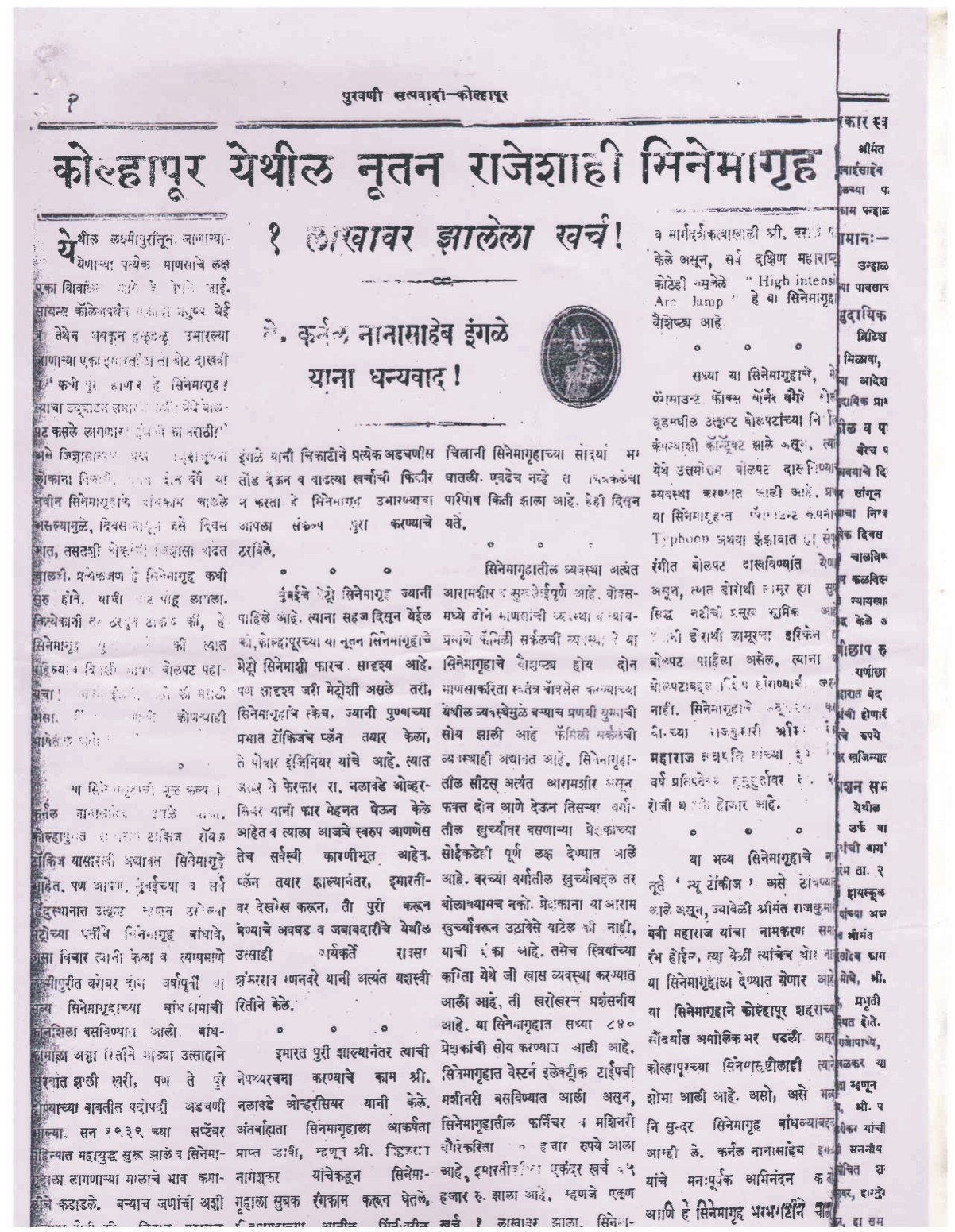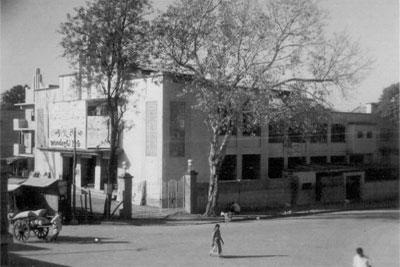
History
The story of Padma Talkies started in 1936. The Late Col. Nanasaheb Dattajirao Ingle- ADC, Military Secretary to HH Rajaram Chhatrapati, Maharaj of Kolhapur, -started the construction of the theatre in the heart of the city. The building layout drew its inspiration from the renowned Metro Cinema of Bombay. The theatre was named New Talkies at first. In 1941, after Princess Padmaraje was born, with the kind consent of Shrimant Punyasheel Tarabai Maharani Saheba of Kolhapur, the name New Talkies was changed to Padma Talkies in the year 1942. The talkie was inaugurated by Lieut. Col P Gaisford, Resident for Kolhapur . After Col. Ingle, his son Shri Dhairyasheelrao Ingle took over the reins and passed on the mantle to his son Ruturaj. Presently Ruturaj’s wife Gauri Ingle is managing the theatre.
Initially Padma Talkies became famous for screening English films. It also had a unique attraction for its patrons – a bar. It was immensely popular with the local residents of Kolhapur as also with the Polish camp residents, who were then living in Valivade on the outskirts of the city, now the Gandhinagar area. Many English classics like Gone with the Wind, Ten Commandments, Ben Hur, Roman Holiday, The Bridge on the River Kwai, Seven Brothers For Seven Brides, Vertigo, Sound Of Music, How To Marry A Millionaire, Absent Minded Professor, Cleopatra, Come September, Niagara, Mackennas Gold, Psyco, The Magnificent Seven, The Snows of Kilimanjaro, Bhowani Junction, Scaramouche,Dial M for Murder, Hatari, One Eyed Jack, Julius Caesar, The Gladiators, Mummy, MI Series, 300, and 2012. Irrespective of language constraints, the popular comedy films of Laurel & Hardy (entitled loosely as Jadya & Radya in Marathi) witnessed high viewership. The show timings were 3, 6 & 9 pm while the matinee 10 am show slot was fixed exclusively for the Laurel & Hardy movies.
The Padma Talkies also catered to the local Marathi audiences by showcasing a number of famous films of the bygone era – Swarajyacha Seemevar, Shevgyachya Shenga, Manini, Doodh Bhaat, Amhi Jato Amchya Gaavi, Ithe Shahane Rahatat, Hi Marathichi Nagari, Ranglya Ratri Ashya, Bala Jojo Re, Bala Gau Kashi Angayee, Jyoyibacha Nawas, Chimni Pakhre, Balgandharav, among a host of others. The film Manini ran for 75 weeks, of which the first 4-week shows were arranged exclusively for women. The film Bala Jojo Re also had 2 weeks of special screening for women only. Jyotibacha Nawas ran for 23 weeks and thereafter for the next 7-8 years, the film was screened specially during the deity Jyotiba’s Yatra. The 3 pm show was reserved for women and the theatre provided separate seating arrangements for women for all the other shows.
Hindi films, the theatre’s mainstay, have seen hugely successful runs at the theatre. V. Shantaram’s iconic film Navrang ran for 31 weeks and Bhakti Pundalik for 30 weeks. Tohfaa ran for 25 weeks, Dil To Pagal Hai ran for 35 weeks, Raja Hindustani for 13 weeks of which 6 weeks were houseful. When Ek Duje Ke Liye completed 26 weeks, Producer Mr L.V.Prasad was so pleased that he came to Kolhapur & handed over a bonus to the theatre staff in person. The other blockbusters screened over the years were Anmol Ghadi, Chitralekha, Nal Damyanti, Prithvi Vallabh, Akela, Jugnu, Bhakta Pundalik, Dahej, Maldaar, Raja Harishchandra, Mayurpankhi, Ayodhya Patti, Gunga Jumuna, Navraang, Chaudavi Ka Chand, Hum Dono, Mere Mehboob, Ganga Ki Lehre, Geet Gaya Patharo Ne, Guide, Bluff Master, Kashmir ki Kali, Around The World, Kala Pathar, Andhi, Aradhana, Dushmaan, farz Jeevan Mrityu, Johnny Mera Naam, Milan, Kabhie Kabhie, Sasural, Khoobsoorat, Disco Dancer, Nadiyaan Ke Paar, Pukaar, Meri Jung, Naache Mayuri, Naseeb Apna Apna, Dil Hai Ki Manta Nahi, Tridev, Lamhe, Aaj Ka Goondaraj, Aankhein, Hum Hai Rahi Pyaar Ke, Mohra, Karan Arjun, Gupt, Kuch Kuch Hota Hai, Hum Dil De Chuke Sanam, Taal, Kabhi Khushi Kabhi Gam, Koi Mil Gaya, Rang De Basanti, Dhoom Series, Chak De India, Tare Zameen Par, Dabaang 1 & 2, Rowdy Rathore, Ek Tha Tiger, Bhaag Milkha Bhaag, Kick, PK, Badlapur. For the last 20 years, Yash Raj Films, Dharma Productions and UTV have always found screening space at the theatre. Prior to this L V Prasad, Rajashri, Shringar Films, BRA Films and Modern movies preferred Padma as their choice of screen. The staff fondly recalls that when Mohra was screened, after a few days repeat audiences would pay full ticket price only to see the then popular hit song ‘Tu Cheez Badi Hai Mast Mast’ in the film and leave the theatre promptly thereafter.
The marketing of films in the earlier days was done by displaying the posters on pushcarts through the city. Padma Talkies used to commission Shri G. Kamble, a local artist, to hand paint the film posters 4-10 days before each new release at the theatre venue itself. When Ganga Jamuna was due for release, the film’s posters painted by G. Kamble graced the theatre’s every wall. The posters of the film Ghoonghat’ were creatively executed by him on a real bridal veil – ‘a ghoonghat’. The public flocked to the theatre precincts to see his labour of love, especially the posters of Shri Dilip Kumar & those of V Shantaram movies.








